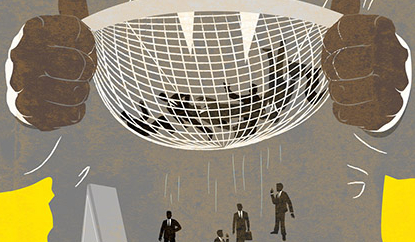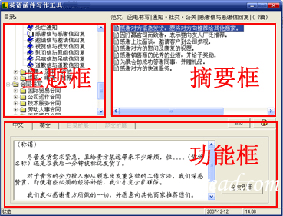国际贸易经典案例九:Hallmark Cards
|
Facing Business Challenges at Hallmark Cards Sending the Right Message to Employees One of Hallmark's sympathy cards reads "Please remember that winter's darkness emerges into spring." Given the troubles at Hallmark Cards, it's just the kind of message that Human Resources vice president Ralph Christenson wants to send to employees. From the early- to mid-1990s the privately held greeting card firm saw its market share slip from well over 50 percent to about 45 percent, as new players in the market made cards that were more attractive and up to date. Even though Hallmark sales remained strong at about $4 billion annually, many profit measures slipped dramatically. It's hard to say just how bad things were because Hallmark profits are kept secret, even from the 20,000 employees who own part of the company. But it wasn't good news when-Hallmark's profit-sharing contributions slipped from 10 percent of salaries to about 5 percent. Newly arrived in the Human Relations department, Christenson needed to find ways of keeping company employees happy. After all, the company's core mission is to communicate affection, love, and friendship through the warm messages that employees dream up. Hallmark started out in 1910 as a family-run business, and the Hall family's leadership continues today. Based in Kansas City, Missouri, the company has always attracted talented and creative people through its friendly and family-oriented atmosphere. Because Hallmark products are based on enhancing relationships, it stands to reason that the company would focus on keeping employees happy. For example, back in the 1950s, the Hall family set up one of the first profit-sharing arrangements for employees. Today, employees own about one-third of the company. In addition, the tuition-reimbursement program pays 100 percent of education expenses for fulltime staff. Other initiatives focus on child care and alternative work arrangements such as work sharing and job sharing. And the company's policies are flexible to meet employees' special needs, such as allowing time off to care for aging parents. Overall, the company has always done such a good job helping its employees that Hallmark consistently ranks among the best companies to work for in the United States. But in the mid-1990s Hallmark faced declining market share and shrinking profit. Consultants suggested major cost-cutting efforts, including a merger of the administrative, marketing, and product-development functions for the various card brands. To save money, Hallmark threw out its old organization and the ways that employees had beep doing their jobs. With the new focus on finances, employees were concerned that their family-oriented benefits would disappear. Moreover, many employees feared that their jobs would be changed dramatically or eliminated altogether. The organization was in turmoil. Christenson had come to Hallmark because he believed the company cared deeply about its employees as people. Because of management's recent sharp focus on corporate profits, Christenson worried that Hallmark wouldn't be able to keep up its long tradition of caring for employees and their families. For the company to see its way through the current crisis, he had to inspire the employees who create and produce Hallmark products. Christenson needed new ways to strengthen the family-oriented programs and shore up morale. If you were Ralph Christenson, what motivational techniques would you employ to keep Hallmark operating at peak levels? During times of massive organizational change, what would you recommend to reassure employees and help them deal with stress? How could you improve the company's communication with employees. What steps would you recommend for maintaining Hallmark's traditional focus on employee needs? Meeting Business Challenges at Hallmark Cards As the new vice president of Human Relations, Ralph Christenson was facing restructuring and disruption at Hallmark. Rumors of layoffs or massive job change and loss of benefits echoed along the corridors of Hallmark's Kansas City headquarters. Employees worried that profit sharing might be cut and that other important benefits such as child-care help, tuition reimbursement, and work sharing would be lost. Always known for its family-oriented atmosphere, the company had consistently ranked among the best places to work in America. But now employees' faith in Hallmark wavered, and Christenson needed to reassure company employees that things would work out. Although Hallmark Cards was a healthy company, management knew the underlying cost structure was too high. Moreover, the time it took to deliver new products to market was as much as three years, far too long when customer tastes can change rapidly and the competition can react more quickly. So with the help of outside consultants, Hallmark's management developed several strategies to reduce costs and introduce products with greater speed. During this time of change, preserving employee jobs and improving morale were Christenson's primary concerns. So he developed a creative solution for containing costs by looking beyond what people were originally hired to do. To retain employees displaced by the merger of three divisions, Christenson developed a program for retraining factory workers to l1andle office jobs. Yet another group of factory employees helped paint an operating plant while receiving their standard wages. When factory work is slow, employees can even choose to volunteer for community work while drawing their usual paychecks. And no employee with more than two years with the company can be let go without a case review by company executives. So with Christenson's help, Hallmark was able to perpetuate its special caring for employees and its history of no layoffs. Then to speed up the time it takes to develop and introduce new card products, Christenson helped Hallmark create cross-functional teams. Before these changes, Hallmark artists, designers, printers, and financial staff were working as much as a city block apart even though some of them were working on the same card design. With the new team concept, these employees have been brought together into one room to create, develop, cost-justify, and produce new cards. This approach cut the overall time to market from three years to about one year and helped Hallmark compete more effectively in the rapidly changing greeting card business. Employees quickly adapted to the idea of working together in teams, and they embraced the opportunity to learn more about the company's overall operations. Next, Christenson addressed employee benefits. Although workers were generally happy with the existing benefits package, Christenson wanted to offer even more solutions to keep Hallmark employees satisfied. He needed to build a two-way communication channel that allowed him to hear employee concerns firsthand; he set up a series of feedback sessions in which employees could tell him what was on their mind. As a result, Christenson reorganized the human relations department to focus on a number of themes important to employees |








